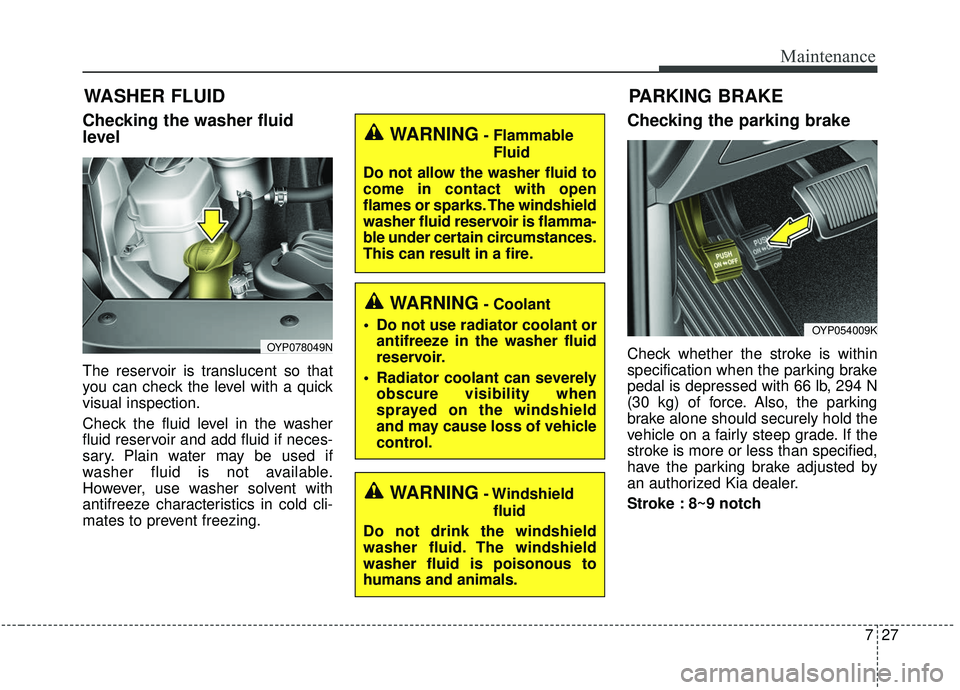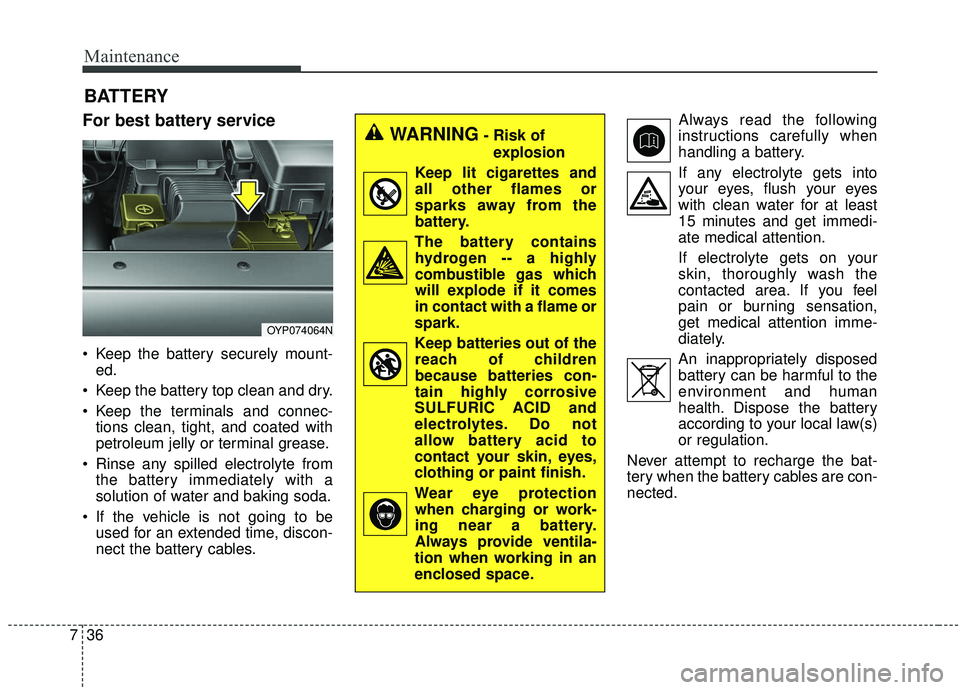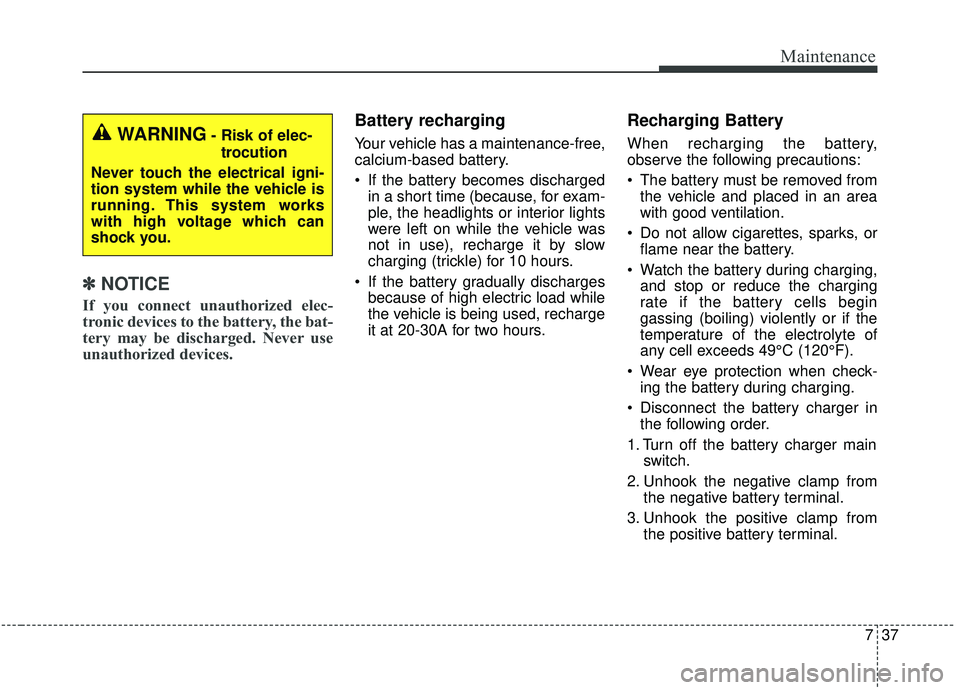2019 KIA SEDONA Spark
[x] Cancel search: SparkPage 494 of 593

727
Maintenance
WASHER FLUID
Checking the washer fluid
level
The reservoir is translucent so that
you can check the level with a quick
visual inspection.
Check the fluid level in the washer
fluid reservoir and add fluid if neces-
sary. Plain water may be used if
washer fluid is not available.
However, use washer solvent with
antifreeze characteristics in cold cli-
mates to prevent freezing.
Checking the parking brake
Check whether the stroke is within
specification when the parking brake
pedal is depressed with 66 lb, 294 N
(30 kg) of force. Also, the parking
brake alone should securely hold the
vehicle on a fairly steep grade. If the
stroke is more or less than specified,
have the parking brake adjusted by
an authorized Kia dealer.
Stroke : 8~9 notchOYP078049N
OYP054009K
PARKING BRAKE
WARNING- FlammableFluid
Do not allow the washer fluid to
come in contact with open
flames or sparks. The windshield
washer fluid reservoir is flamma-
ble under certain circumstances.
This can result in a fire.
WARNING- Windshield fluid
Do not drink the windshield
washer fluid. The windshield
washer fluid is poisonous to
humans and animals.
WARNING- Coolant
Do not use radiator coolant or antifreeze in the washer fluid
reservoir.
Radiator coolant can severely obscure visibility when
sprayed on the windshield
and may cause loss of vehicle
control.
Page 503 of 593

Maintenance
36
7
BATTERY
For best battery service
Keep the battery securely mount-
ed.
Keep the battery top clean and dry.
Keep the terminals and connec- tions clean, tight, and coated with
petroleum jelly or terminal grease.
Rinse any spilled electrolyte from the battery immediately with a
solution of water and baking soda.
If the vehicle is not going to be used for an extended time, discon-
nect the battery cables. Always read the following
instructions carefully when
handling a battery.
If any electrolyte gets into your eyes, flush your eyes
with clean water for at least
15 minutes and get immedi-
ate medical attention.
If electrolyte gets on your
skin, thoroughly wash the
contacted area. If you feel
pain or burning sensation,
get medical attention imme-
diately.
An inappropriately disposed battery can be harmful to the
environment and human
health. Dispose the battery
according to your local law(s)
or regulation.
Never attempt to recharge the bat-
tery when the battery cables are con-
nected.
OYP074064N
WARNING- Risk of explosion
Keep lit cigarettes and
all other flames or
sparks away from the
battery.
The battery contains hydrogen -- a highly
combustible gas which
will explode if it comes
in contact with a flame or
spark.
Keep batteries out of the reach of children
because batteries con-
tain highly corrosive
SULFURIC ACID and
electrolytes. Do not
allow battery acid to
contact your skin, eyes,
clothing or paint finish.
Wear eye protection when charging or work-
ing near a battery.
Always provide ventila-
tion when working in an
enclosed space.
Page 504 of 593

737
Maintenance
✽ ✽NOTICE
If you connect unauthorized elec-
tronic devices to the battery, the bat-
tery may be discharged. Never use
unauthorized devices.
Battery recharging
Your vehicle has a maintenance-free,
calcium-based battery.
If the battery becomes discharged
in a short time (because, for exam-
ple, the headlights or interior lights
were left on while the vehicle was
not in use), recharge it by slow
charging (trickle) for 10 hours.
If the battery gradually discharges because of high electric load while
the vehicle is being used, recharge
it at 20-30A for two hours.
Recharging Battery
When recharging the battery,
observe the following precautions:
The battery must be removed fromthe vehicle and placed in an area
with good ventilation.
Do not allow cigarettes, sparks, or flame near the battery.
Watch the battery during charging, and stop or reduce the charging
rate if the battery cells begin
gassing (boiling) violently or if the
temperature of the electrolyte of
any cell exceeds 49°C (120°F).
Wear eye protection when check- ing the battery during charging.
Disconnect the battery charger in the following order.
1. Turn off the battery charger main switch.
2. Unhook the negative clamp from the negative battery terminal.
3. Unhook the positive clamp from the positive battery terminal.WARNING- Risk of elec-
trocution
Never touch the electrical igni-
tion system while the vehicle is
running. This system works
with high voltage which can
shock you.
Page 583 of 593

Index
6I
Explanation of scheduled maintenance items . . . . . . . 7-15Air cleaner filter . . . . . . . . . . . . . . . . . . . . . . . . . . . . 7-16
Air conditioning refrigerant . . . . . . . . . . . . . . . . . . 7-19
Automatic transmission fluid . . . . . . . . . . . . . . . . . . 7-17
Brake discs, pads, calipers and rotors . . . . . . . . . . . 7-18
Brake fluid . . . . . . . . . . . . . . . . . . . . . . . . . . . . . . . . 7-18
Brake hoses and lines . . . . . . . . . . . . . . . . . . . . . . . . 7-17
Coolant . . . . . . . . . . . . . . . . . . . . . . . . . . . . . . . . . . . 7-\
16
Cooling system . . . . . . . . . . . . . . . . . . . . . . . . . . . . . 7-16
Drive belts . . . . . . . . . . . . . . . . . . . . . . . . . . . . . . . . 7-15
Drive shafts and boots . . . . . . . . . . . . . . . . . . . . . . . 7-19
Engine oil and filter . . . . . . . . . . . . . . . . . . . . . . . . . 7-15
Exhaust system . . . . . . . . . . . . . . . . . . . . . . . . . . . . . 7-19
Fuel filter (for gasoline) . . . . . . . . . . . . . . . . . . . . . . 7-15
Fuel lines, fuel hoses and connections . . . . . . . . . . . 7-15
Parking brake . . . . . . . . . . . . . . . . . . . . . . . . . . . . . . 7-18
Power steering pump, belt and hoses . . . . . . . . . . . . 7-19
Spark plugs . . . . . . . . . . . . . . . . . . . . . . . . . . . . . . . . 7-16
Steering gear box, linkage & boots/lower arm ball joint . . . . . . . . . . . . . . . . . . . . . . . . 7-18
Suspension mounting bolts . . . . . . . . . . . . . . . . . . . 7-18
Vacuum crankcase ventilation hoses . . . . . . . . . . . . 7-16
Valve clearance. . . . . . . . . . . . . . . . . . . . . . . . . . . . . 7-16
Vapor hose and fuel filler cap . . . . . . . . . . . . . . . . . 7-15
Exterior care . . . . . . . . . . . . . . . . . . . . . . . . . . . . . . . . . 7-89
Exterior features . . . . . . . . . . . . . . . . . . . . . . . . . . . . . 4-208 Roof rack . . . . . . . . . . . . . . . . . . . . . . . . . . . . . . . . 4-208
Exterior overview . . . . . . . . . . . . . . . . . . . . . . . . . . . . . . 2-2 Flat tire . . . . . . . . . . . . . . . . . . . . . . . . . . . . . . . . . . . . \
. . 6-9
A flat tire indoor storage . . . . . . . . . . . . . . . . . . . . . 6-12
Changing tires . . . . . . . . . . . . . . . . . . . . . . . . . . . . . 6-12
Jack and tools . . . . . . . . . . . . . . . . . . . . . . . . . . . . . . . 6-9
Removing and storing the spare tire . . . . . . . . . . . . 6-10
Storing the spare tire . . . . . . . . . . . . . . . . . . . . . . . . 6-11
Floor mat anchor(s) . . . . . . . . . . . . . . . . . . . . . . . . . . 4-205
Fluid Brake fluid . . . . . . . . . . . . . . . . . . . . . . . . . . . . . . . . 7-25
Power steering fluid . . . . . . . . . . . . . . . . . . . . . . . . . 7-26
Washer fluid . . . . . . . . . . . . . . . . . . . . . . . . . . . . . . . 7-27
Folding key . . . . . . . . . . . . . . . . . . . . . . . . . . . . . . . . . . . 4-\
5 Battery replacement . . . . . . . . . . . . . . . . . . . . . . . . . 4-10
Immobilizer system . . . . . . . . . . . . . . . . . . . . . . . . . 4-11
Key operations . . . . . . . . . . . . . . . . . . . . . . . . . . . . . . 4-5
Record your key number . . . . . . . . . . . . . . . . . . . . . . 4-5
Transmitter precautions . . . . . . . . . . . . . . . . . . . . . . . 4-9
Folding the outside rearview mirror . . . . . . . . . . . . . . . 4-86
Forward Collision-Avoidance assist (FCA) . . . . . . . . . 5-44 Brake operation . . . . . . . . . . . . . . . . . . . . . . . . . . . . 5-48
FCA front radar/Camera sensor . . . . . . . . . . . . . . . . 5-48
FCA warning message and system control . . . . . . . 5-46
Limitation of the system . . . . . . . . . . . . . . . . . . . . . 5-52
Recognizing pedestrians. . . . . . . . . . . . . . . . . . . . . . 5-56
System malfunction . . . . . . . . . . . . . . . . . . . . . . . . . 5-50
System setting and activation . . . . . . . . . . . . . . . . . . 5-44F